By Matt Weber
During a recent bathroom remodel, we had the opportunity to replace cast-iron tub with a new acrylic bathtub. Tubs are available in a number of different designs, and this project covers the American Standard Saver Tub (available at Lowe’s), which is designed to be installed in an alcove and surrounded on three sides by stud walls. This article covers a basic overview of what the project involves, but product details may vary among manufacturers.
After removing the old tub, the most challenging aspect of installing the new one is alignment of the tub’s plumbing components with the drain of the house. The plumbing phase of the project will require careful measurements and secure connections. A new tub will come with detailed instructions concerning the tub’s pipe connections. The rest of the job entails fitting the tub snugly within the surround, supporting it from below, and ensuring the walls will direct water into the basin.
Before you Begin
Local building codes vary by location, and you might need a permit for this project in your area. Follow all codes for building and plumbing.
It’s important to unpack and carefully inspect your new tub upon delivery. On this project, for example, we found that a corner of the tub was damaged—probably crunched by a forklift during shipment. Although the crack was minimal, we worried it would spread and result in a leak, so we decided to return the first tub and get a new one from the supplier.

Also, determine ahead of time what items are included in with your tub purchase, and what you need to purchase separately. We purchased our selected plumbing fittings separately.
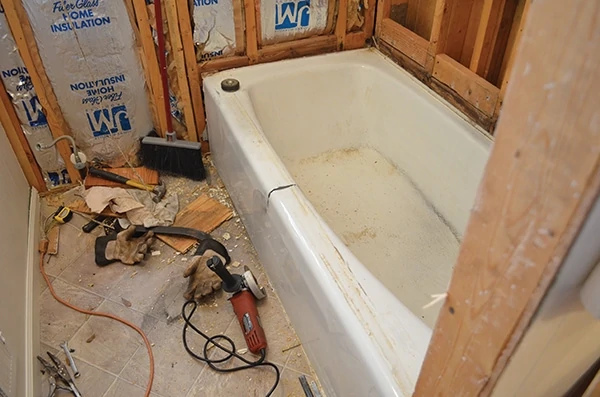

The tub is designed to install in a recess, where three walls are comprised of stud framing, with the fourth acrylic wall exposed. An acrylic tub is not self-supporting, which means it must be supported along its entire bottom with mortar or grout.
It should go without saying that the floor should be solidly constructed to support the weight of the tub, water and the person using it. Since we were replacing an old tub, this project required no changes to the floor construction.

Tools
- Level
- Square
- Tape Measure
- Pipe Wrench
- Slip Joint Pliers
- Screwdriver
- Standard Woodworking Tools
- Personal Safety Equipment
- Caulking Gun
Materials
- Nails
- Plumber’s Putty
- Silicone Sealant
- 1 x 3 or 2 x 4 Stringers
- Drop Cloth
- Mortar Mix or Grout
The recessed area for the tub location should have walls framed with 2×4 or steel studs, according to the rough opening dimensions provided by your tub’s manufacturer. The rough-in framing must be plumb and square. In general, 2×4 wall studs spaced on 16-in. will suffice.
In our particular situation, a vent pipe from a first-floor bathroom that routed up through one of the surrounding walls complicated the framing in our upstairs bathroom. The old vent stack was larger than the 3-1/2-in. wall studs, so we had to shim out the rear wall studs to enclose the pipe. You might face similar obstacles that require you to take such measures.
Another note about framing the surround: Plan in advance if you want to include any recessed nooks, shelves or other accessories, and frame them accordingly. Even bolt-on accessories will require solid between-the-stud framing to mount them, so go ahead and install the 2x blocking while the walls are open.

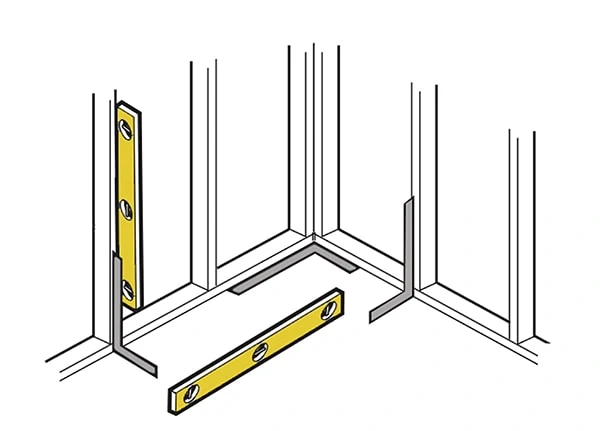
Once the wall framing is complete, horizontal stringers should be installed across the studs to support the edge of the tub deck. Mark their position by tracing a level line onto the studs at the height indicated in the tub’s instruction manual. Align the top of each stringer and nail or screw them to the studs.
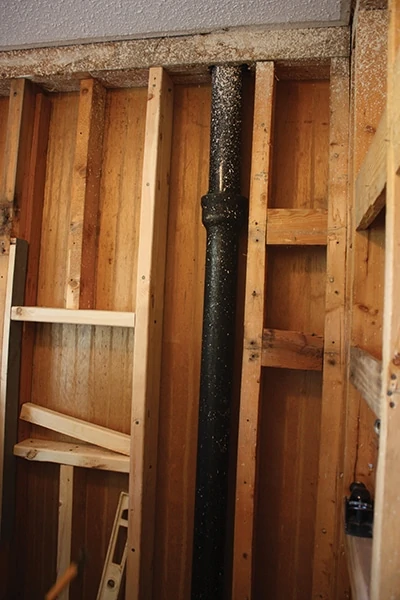
The American Standard tub shown in this project has an installed size of 60 x 30 x 18 inches. The instructions map out the location for the drain, based on measurements from the surrounding walls. Proper alignment of the plumbing connections with the house drain is crucial.

Note: It’s a good idea to have an additional opening to access to the tub’s drain components during installation. In our case, we were working on an upstairs bathtub, so we cut access through the floor, and connected the plumbing from below. Another option is to access the drain through a hole in the partition wall, which can later be finished or hidden inside a vanity cabinet.
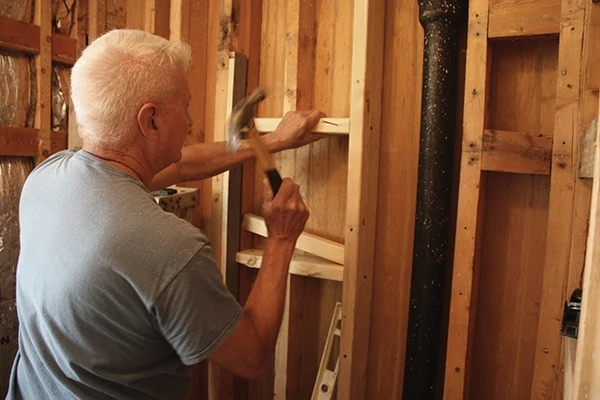
With the tub site fully prepped, recruit an assistant to help dry-fit the tub into place. This will help you troubleshoot any problems in advance of using wet mortar. For example, we discovered some tight clearances around surrounding obstacles (toilet supply valve, opposing bathroom wall, etc.) which made placement tricky and required a bit of planning and practice.
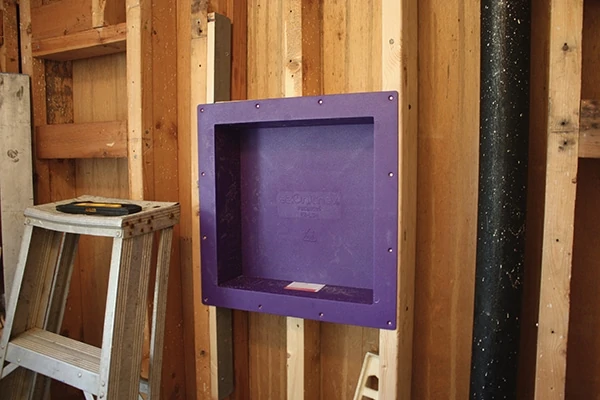
Install the drain components to the bath following the manufacturer’s instructions. See the installation manual for suggested opening size and location dimensions. We used a “universal drain kit” with PVC components.

Before installing the tub, it’s important to note that the stringers are meant to level and strengthen the tub deck but in no way should they be expected to support the weight of the tub, which must be supported along its entire bottom. We applied a bed of mortar (sand not recommended) to cover all points of contact between the tub and the subfloor. Measure the distance from the tub’s bottom to where it will meet the floor to determine the required depth of the mortar bed.


Mix the mortar with water according to the package directions. We used a shovel and garden hose to churn it up in a wheelbarrow. Aim for a consistency similar to the thick, wet sand you might use to build a sandcastle. Don’t mix it too thin, or the mortar might spread out beneath the tub without providing adequate support.


After pouring the bedding and troweling it into place (and before it sets), position the bath within the recess until the rim is leveled against the leveling stringers. Remember, the rim of the bath must not support weight. Allow the mortar bedding to completely harden before applying weight to the rim or bottom of the bath.
Check the tub’s level front to back and side to side, shimming it as necessary. Secure the tub to the studs with nails or drywall screws and flat washers above the flange of the bath.



is damp and thick.
Trowel the mortar onto the floor of the rough opening, forming a bed thick and broad enough to support the complete bottom of the tub.
Connect the bath drain to the waste line and tighten all drain joints securely. Seal all joints around the tub with a flexible, mildew-proof sealant.


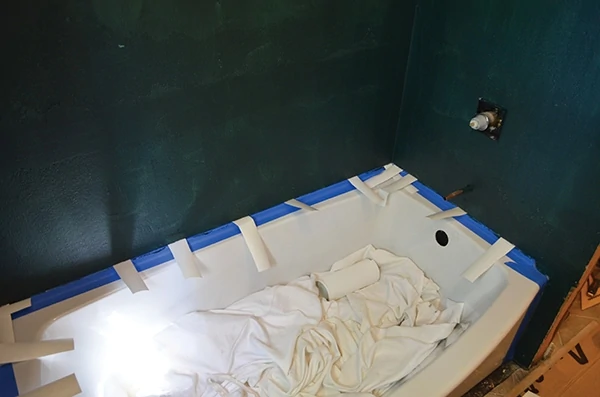
Those are the basic steps of an acrylic bathtub installation, but you’ll still need to build the tub surround in such a way to ensure water is diverted away from the walls and into the tub. For this project, we covered the walls with cement board and liquid waterproofer, then applied wall tiles with tile adhesive.


The finished project provided a more spacious bathing environment, thanks to the flared design of the new tub. The new tile walls look beautiful and feature an integrated shelf and a mosaic stripe accenting the surround, which greatly improved the room’s interior décor.

Side Note
Schluter Kerdi-Board Kit Components
Tiled shower walls are luxurious, hygienic and easy to maintain. Whether the setting is a tub surround or a standalone shower, the walls must be waterproof before the tiles are installed. Schluter Systems’ new Schluter-Kerdi-Board Kit includes everything needed to build waterproof walls for a standard tub surround or an acrylic shower base, all in a package that can easily fit into most vehicles.
The kit creates a completely waterproof environment and eliminates the possibility of damaging leaks and mold growth due to moisture penetration. The kit includes eight pieces of 1/2-in. thick Kerdi-Board waterproof building panels that can be screwed directly onto wall studs to build a waterproof tub surround or shower area. These building panels are the first step in getting the walls ready for tile installation. The panels are 48×38-in. so they are a very manageable size and can easily be cut with a utility knife to fit any wall space up to 101 sq. ft.
The Kerdi-Board panels are lightweight, don’t generate dust when cut, and completely eliminate the need for gypsum or cement board on the shower walls. The panels are installed with screws and washers that are included in the kit. Once the panels are up, only the seams between panels and the screw penetrations need to be waterproofed to complete the walls. The kit includes a 5-in. wide strip of Kerdi-Band waterproof membrane that can be cut and then installed using thin-set mortar to seal these areas. Tiles are then set directly onto the Kerdi-Board with thin-set mortar. This system is not only waterproof but vapor-tight, so it won’t leak or promote mold growth.
The kit also includes two tubes of Kerdi-Fix sealing and bonding compound to create a waterproof seal around the flange of the tub or shower base. This is a particularly vulnerable area for moisture penetration, so obtaining a proper waterproof seal where the tiles meet these elements is critical. Other components in the kit are a 4-1/2-in. mixing valve seal, a 3/4-in. pipe seal, and a 1/2-in. pipe seal to ensure that no moisture can enter the wall cavity where the plumbing fixtures protrude into the shower area. For more information, visit www.schluter.com.




